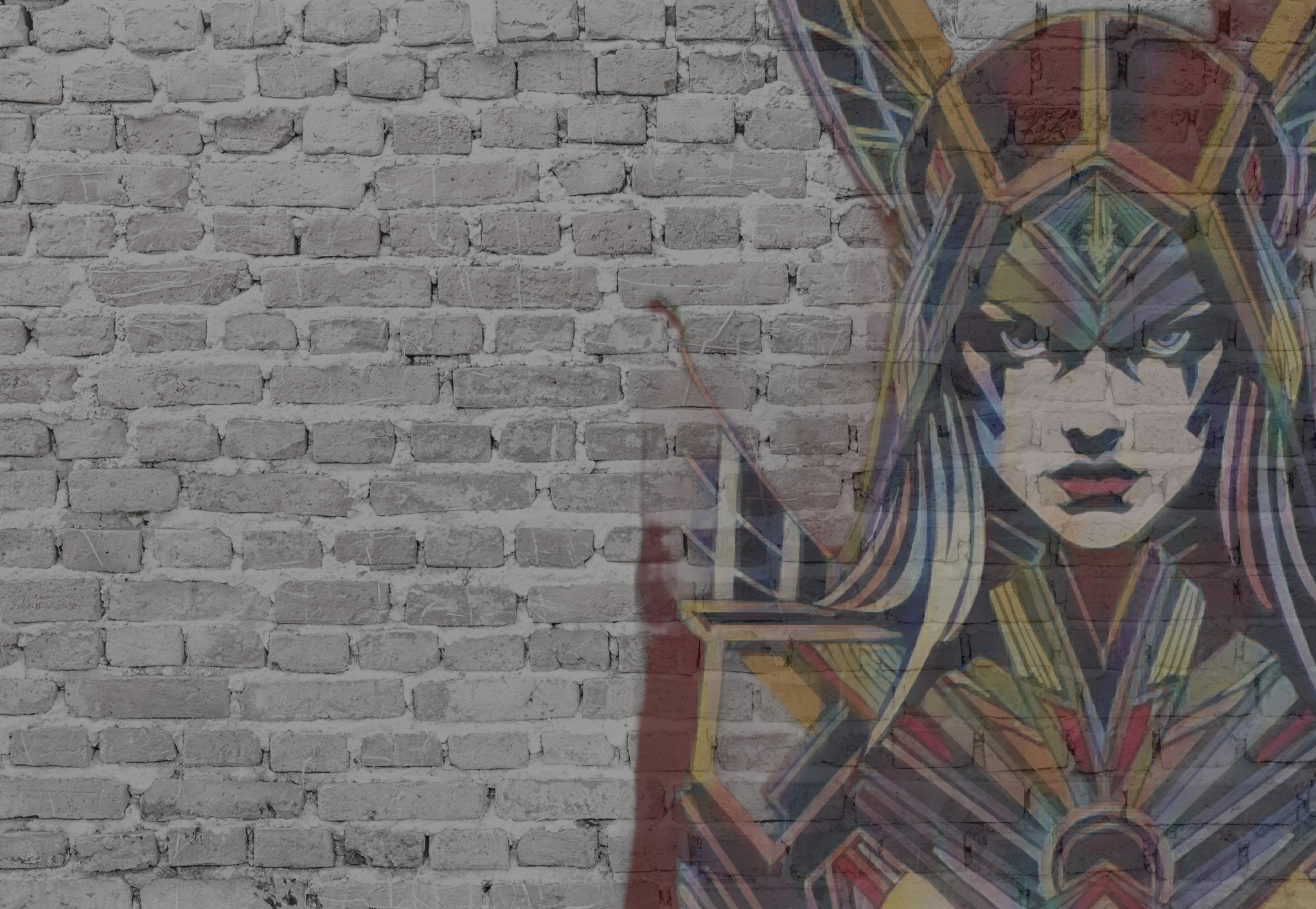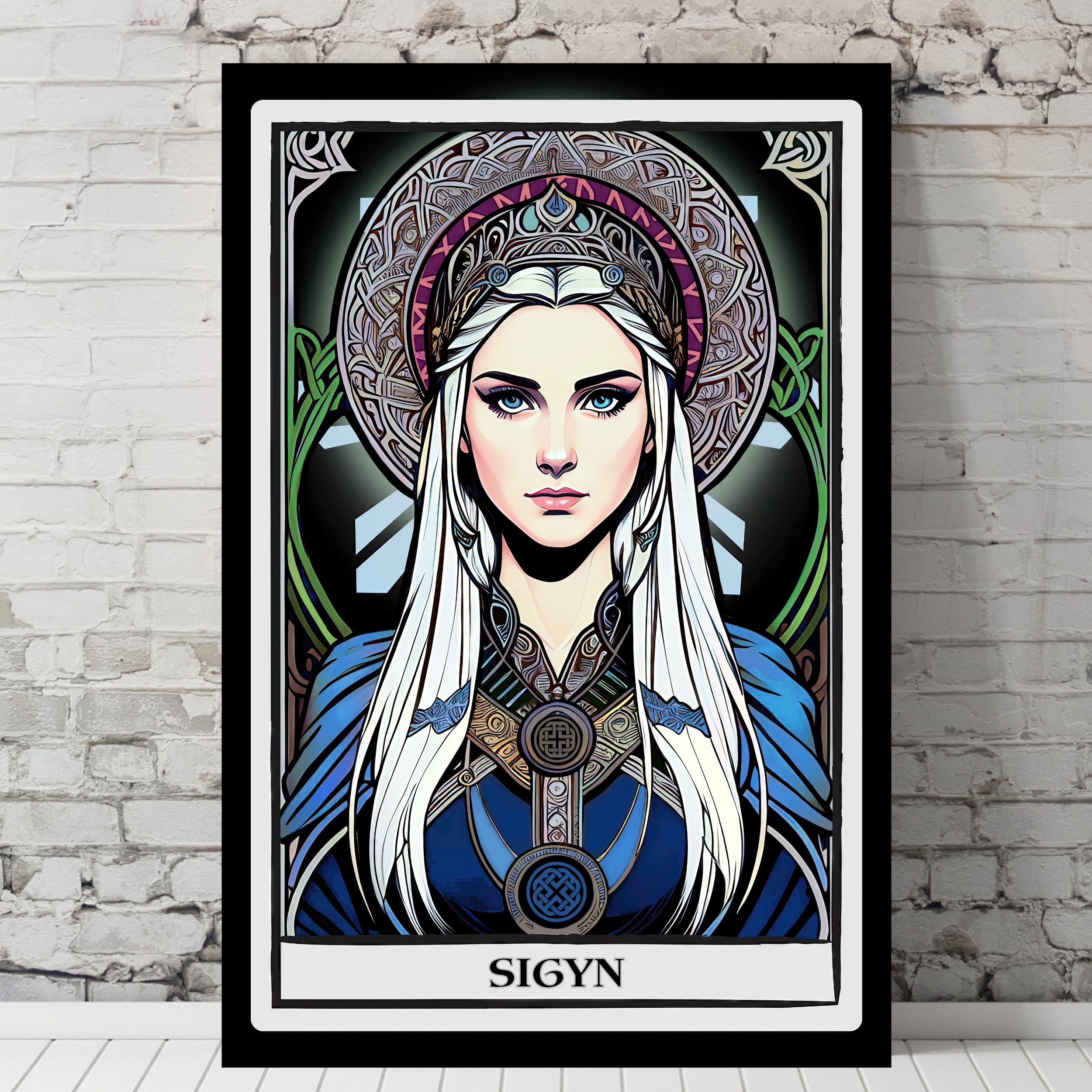
Olensdóttir
Matte fine art prints of original illustrations and paintings. Printed on archival, museum-grade paper, in various sizes. Currently for sale in my Etsy shop, Olensdottir.
-

Freyja
Freyja, the radiant goddess of love, beauty, and war, is one of the most powerful and multifaceted figures in Norse mythology. A member of the Vanir, she is associated with desire, magic (seiðr), and the mysteries of fate. She rides a chariot drawn by cats, wears the fabled Brísingamen necklace, and claims half of the fallen warriors in battle, taking them to her hall, Fólkvangr, while Odin receives the other half in Valhalla. Freyja embodies both passion and ferocity, ruling over both life’s pleasures and the grim realities of war.
-

Skadi
Skaði, the formidable jötunn goddess of winter, mountains, and hunting, is a figure of strength and independence in Norse mythology. Daughter of the slain giant Þjazi, she stormed Ásgarðr seeking vengeance but instead secured a peculiar marriage to the god Njörðr as compensation. Their union, however, was short-lived—Skaði longed for her icy mountain home, while Njörðr preferred the sea. Often depicted with a bow and skis, she embodies the fierce, untamed spirit of the wilderness. Though associated with frost and isolation, Skaði’s presence in the myths reflects the Norse reverence for resilience, self-reliance, and the raw beauty of nature’s harshest landscapes.
-

Njord
Njǫrðr, the Vanir god of the sea, winds, and wealth, is a vital figure in Norse mythology, embodying prosperity and the bounties of the ocean. Revered by seafarers and fishermen, he ensures calm waters and plentiful catches. Though originally of the Vanir, he became an Æsir hostage after the war between the two godly tribes, fostering peace through his presence in Ásgarðr. His brief and ill-fated marriage to Skaði highlighted their stark differences—he loved the sea’s gentle lull, while she longed for the icy mountains. Despite this, Njǫrðr remained a beneficent deity, bringing abundance and protection to those who relied on the waves for survival.
-

Freyr
Freyr, a prominent Vanir god, is associated with fertility, prosperity, and peace. Revered as a bringer of bountiful harvests and ruler over Alfheimr, the realm of the elves, he embodies abundance and harmony. Freyr wields the golden boar Gullinbursti and once possessed the enchanted sword that could fight on its own—though he sacrificed it for love when he gave it up to win the giantess Gerðr’s hand. Despite his peaceful nature, this loss would ultimately seal his fate at Ragnarök. As a god of kingship and plenty, Freyr was widely venerated, ensuring prosperity for those who honored him.
-

Sigyn
Sigyn is a goddess in Norse mythology, best known as the devoted wife of Loki. Her name is often interpreted to mean "Victory-Giver" or "Friend of Victory." While she is not as prominently featured as other deities, her role in Lokasenna and Gylfaginning reveals her deep loyalty and endurance.
Despite her limited mentions in the surviving texts, Sigyn’s presence suggests an important archetype in Norse mythology: the steadfast and enduring companion who remains loyal even in the face of great suffering. Some modern interpretations see her as a goddess of compassion, resilience, and fidelity.
-

Skuld
In Völuspá, Skuld is named as both a Valkyrie and a Norn, embodying fate and battle alike. As one of the three primary Norns—alongside Urðr (the past) and Verðandi (the present)—Skuld represents the future, weaving the destiny of gods and mortals alike. But unlike her sisters, she also rides to war, choosing who will fall in battle. This dual role ties her to Ragnarok, where she plays a part in shaping the inevitable doom of the gods. In some depictions, Skuld leads legions of slain warriors, ensuring that fate unfolds as it must. Her name itself means "debt" or "what is due," emphasizing the inescapable nature of destiny.
-

Skogul
In Völuspá, Skǫgul is named among the Valkyries who ride forth to the battlefield, selecting which warriors will fall and be taken to Valhalla. Her name, derived from Old Norse, is often translated as "shaker" or "high tumult," emphasizing her role in the chaos of war. As one of Odin’s battle maidens, Skǫgul is both a harbinger of death and an escort to glory, ensuring that worthy souls join the Einherjar in preparation for Ragnarok. She is mentioned in various Norse sources, sometimes in tandem with Gunnr, reinforcing her role as a powerful force in battle and fate.
-

Geirskogul
Geirskǫgul, whose name can be translated as "Spear-Shaker" or "Spear-Skǫgul," is a Valkyrie mentioned in Völuspá and Skáldskaparmál. Her name suggests a fierce warrior aspect, tied directly to the chaos and precision of battle. As one of Odin’s battle-maidens, she determines who will fall in combat and who will be taken to Valhalla to join the ranks of the Einherjar. In Hákonarmál, Geirskǫgul and Skǫgul are depicted as messengers sent by Odin to bring the fallen King Hákon to the halls of the gods, reinforcing their role in shaping the fate of warriors. Her presence in multiple sources highlights her importance among the Valkyries, embodying both the destructive power of war and the honor of those chosen for Valhalla.
-

Frigg
Frigg is the queen of the Æsir and the wife of Odin in Norse mythology, known for her wisdom, foresight, and role as a motherly protector. She is one of the most powerful goddesses, often associated with marriage, motherhood, and destiny. Unlike many of the other gods, Frigg has the gift of prophecy but chooses to keep her knowledge secret. She is often compared to Freyja, as both are associated with love and magic, though Frigg's magic is more focused on foresight and destiny. She is sometimes linked to spinning and weaving, symbolic of the threads of fate. Her dwelling, Fensalir (“Marsh Halls”), is said to be a place of great peace and sorrow, reflecting her role as a goddess who carries both wisdom and grief.
-

Rán
Rán is the Norse goddess of the sea, known for her deep, mysterious, and often treacherous nature. She is the wife of Ægir, the giant who personifies the ocean, and together they rule over the waters. Unlike Ægir, who is sometimes depicted as a hospitable host to the gods, Rán has a more ominous reputation—she is said to capture sailors with her net, dragging them to the depths of the sea.
Her name, meaning "robbery" or "plunder," reflects her role as a force that claims lives and treasures alike. The drowned are considered to be taken by Rán, and many seafarers would offer gold to her before a voyage in hopes of appeasing her and ensuring safe passage. She is also the mother of the nine wave maidens, who personify the different aspects of the sea.
While feared for her power over life and death in the ocean’s grasp, Rán is also a figure of deep, untamed beauty, embodying the sea’s dual nature—both giver and taker, calm and stormy, alluring yet perilous.
-

Baldr
Baldr (also spelled Baldur in some texts) is one of the most beloved gods in Norse mythology, known for his beauty, wisdom, and fairness. He is the son of Odin and Frigg, and his story is one of the most tragic in the mythology. Baldr was invulnerable to almost all threats, as his mother, Frigg, made every being on Earth swear an oath not to harm him. However, she overlooked the mistletoe, which Loki, the trickster god, used to craft a spear that ultimately killed Baldr, setting off a chain of events that would lead to Ragnarök, the end of the world.
Baldr's death is symbolic of the fragility of even the most perfect and beloved among gods. His death is mourned by all, including his mother Frigg, who is said to have wept tears that turned into gold. Baldr is often associated with light and purity, and in some stories, he is even said to return after Ragnarök, representing hope and renewal for the gods and the world. His story highlights themes of fate, sacrifice, and the inevitable decline of even the most divine beings.
-

Áine
Áine, an Irish goddess of love, fertility, and sovereignty, is deeply tied to the land and the cycles of nature. She is often associated with the summer sun, bringing warmth, abundance, and vitality to the earth. Legends depict her as both a radiant deity and a fairy queen, ruling over the sídhe of Cnoc Áine in Limerick. As a goddess of sovereignty, she had the power to grant kingship, symbolizing the sacred bond between ruler and land. Though benevolent, Áine also had a fierce side, punishing those who wronged her. Revered as a bringer of prosperity and protector of women, her presence endures in Irish folklore and midsummer traditions.
